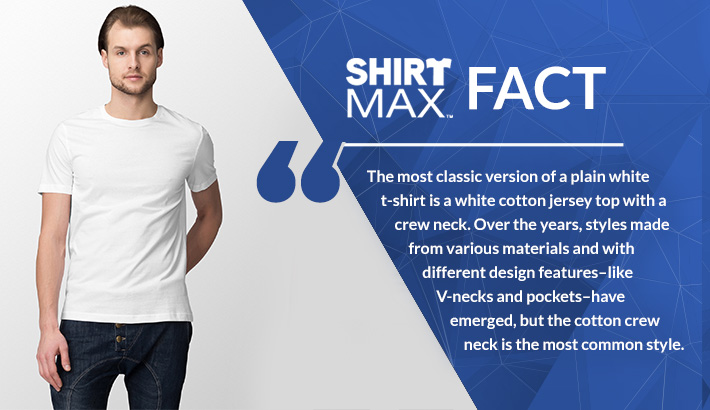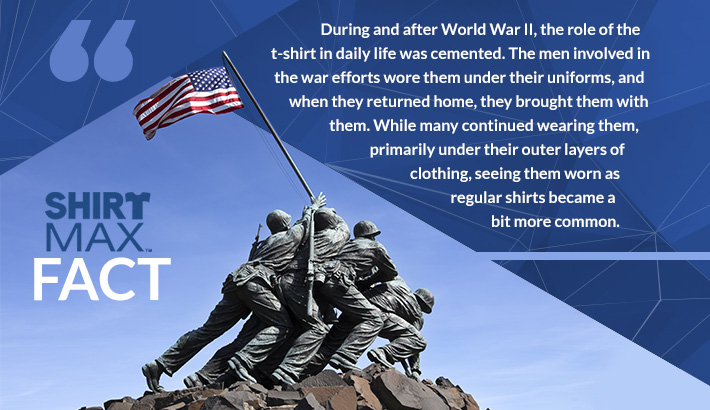Elvis reported for the draft wearing one. Bruce Springsteen wears one on stage as a performer who embodies the archetypical working-class everyman. In Grease, Danny Zuko exuded sexiness wearing one under his leather jacket. James Dean wore one in the classic Rebel Without a Cause. Rocker Kurt Cobain launched the grunge style by pairing his with a flannel button down. Even Kanye West has gotten in on the action by selling his own $120 version of it.
What are we talking about, exactly?
The plain white t-shirt.
The plain white t-shirt has been a fashion staple for decades. You might even be wearing one right now, or you may wear one under your uniform every day when you go to work. No matter how you wear it, there is a good chance that you have at least one folded up in a drawer or hanging in your closet. Few apparel items are as iconic as a plain white t-shirt. Most of us own them, yet few of us know very little about their history.
Let’s change that!
Believe it or not, the modern t-shirt can trace its roots all the way back to the middle ages. While they looked quite different back then, they served as the foundation for the shirts many of us wear on nearly a daily basis. Keep reading to learn more about the history of the ubiquitous plain white t-shirt.
The Plain White T-Shirt’s Humble Beginnings
The most classic version of a plain white t-shirt is a white cotton jersey top with a crew neck. Over the years, styles made from various materials and with different design features–like V-necks and pockets–have emerged, but the cotton crew neck is the most common style.

T-shaped shirts made from linen, wool or silk were common in early medieval times. While they looked quite different from what we now visualize when we think of t-shirts, they did serve as the inspiration for the ones worn today. They were made by joining front and back sections of fabric at the sides and shoulders, and the materials they were made of were largely dependent on the wearer’s socio-economic status. They were worn under coarser outer garments both to protect the skin and to keep sweat from damaging the finer top layer.
By the nineteenth century, undergarments were being laundered more frequently, and they needed to be made from materials that would stand up to frequent washing. Thanks to the Industrial Revolution in the United States and the–unfortunate–rise of slavery, cotton became a widely traded raw material. Cotton is durable, comfortable and widely available. Thus, it became a popular material in the clothing industry.
In 1868, the now infamous union suit was patented in New York, and it served as the most common type of underwear for decades. Some versions existed even before the design was officially patented. Now often mocked for its iconic “butt flap,” the union suit was famously difficult to put on and take off, so clearly, there was room for improvement. Still, though, a considerable amount of time would pass before people would start separating their union suits into two pieces and, eventually, develop the modern tee.
The First “Modern” T-Shirts
Around the turn of the 20th century, companies like Cooper’s (which later became Jockey), Fruit of the Loom and Hanes split the union suit into two pieces, creating undergarments that resembled what we now know as long johns. They were designed so that the top could be neatly tucked into the bottoms to create undergarments that felt similar to a union suit but were easier to put on and take off. These two-piece bisected union suits were commonly worn by soldiers, miners and other laborers as underwear. They were even frequently worn by women.
During the Spanish-American War in 1898, the U.S. Navy issued undershirts from the bisected union suit design to soldiers to wear under their uniforms. Shortly thereafter, Hanes started producing short-sleeved cotton t-shirts for the U.S. Marine Corps. Around the same time, other companies began marketing these undergarments to civilians using advertisements that touted their high-quality construction, comfort and ease of maintenance. At this point, they were still primarily worn as undergarments and were deemed inappropriate to wear on their own. In some particularly hot climates, though, commanding officers did allow troops to remove their outer uniform shirts and wear just the undershirts.

During and after World War II, the role of the t-shirt in daily life was cemented. The men involved in the war efforts wore them under their uniforms, and when they returned home, they brought them with them. While many continued wearing them, primarily under their outer layers of clothing, seeing them worn as regular shirts became a bit more common.
T-Shirts in Popular Culture
While t-shirts came from humble beginnings and were worn primarily for utilitarian purposes, it did not take long for them to make their way into popular culture. In 1947–two years following the end of World War II–A Streetcar Named Desire made its Broadway debut. In addition to establishing Tennessee Williams as a member of the literary elite, it catapulted Marlon Brando to stardom. And what did the young Brando wear while starring in the play? A pair of tight Levi’s 501 jeans and a plain white t-shirt.
The costume designer dressed him in this way to showcase his physique and to imply a sort of nudity that couldn’t actually be portrayed in film or on stage at the time. Because t-shirts were still largely regarded as undergarments, they were to men what nightgowns were to women. They hinted at nudity without upsetting the sensors. Even when A Streetcar Named Desire was brought to the big screen, Brando was still dressed in his classic t-shirt.
In 1955, the melodrama Rebel Without a Cause addressed societal concerns surrounding teenage delinquency. And what was the bad boy James Dean wearing for his role in the movie? A white tee, of course. The t-shirt became the uniform of the under-disciplined teens born from parents who survived the Great Depression and World War II. They were associated with rebellion and sexiness that just wasn’t socially acceptable at the time, so they had a lot of shock value.

By the mid-1960s, though, the shock had all but worn off. The rebellious teens from the mid-50s became a major sales demographic, and manufacturers knew if they mass-produced t-shirts, consumers would be more than willing to buy them. Big brands like Disney and even musicians like The Beatles also recognized that if they emblazoned t-shirts with their images and slogans, teens and young adults would buy them. And by adding their own branding images, they could essentially turn customers into walking billboards.
In the late ’60s and ’70s, the plain white tee got a colorful update. The emergence of tie-dye made it quick and easy to create a rainbow of colors on any white shirt. Bands of all types started screen printing things like logos and tour dates on shirts and selling them at their concerts. You can still find originals of these shirts in thrift shops, and reproductions are sold around the world.
T-shirts were still “cool” throughout the ’70s, but they quickly lost their “rebellious” status. Most people came to realize that tees are great because they’re comfortable, durable and easy to maintain and that they just make sense in wardrobes. And the rest, as they say, is history.
The Modern T-Shirt
Today, you can see t-shirts just about everywhere. From infants to senior citizens, everyone wears them. By the 1990s, they became staples of fast fashion. While things like Fruit of the Loom and Hanes t-shirts sold in bulk are still quite common, they’ve gone far beyond their roots as undergarments and workwear. Big names in the fashion world have given these humble shirts the designer treatment. From Karl Lagerfeld, who paired a plain white tee with Chanel’s tweed cardigan in 1991, to Kanye West, whose $120 plain white “Hiphop” t-shirt sold out in minutes, there are countless examples of the t-shirt ascending from its humble roots to become a major star in the fashion world.

While cotton t-shirts remain one of the most popular choices, these shirts can be made from other materials, too. Polyester is a synthetic fabric that is wrinkle-resistant and extremely durable. It is widely used to make t-shirts that are intended for athletic wear. Shirts made from blends of cotton and polyester are also common because they combine the benefits of each material in one comfortable, long-lasting fabric.
Along these lines, different styles of t-shirts have also emerged. In addition to the classic crew neck tee, there are also V-neck tees, tank tops, long-sleeved t-shirts and more. Even polo shirts and camisoles owe the basis of their style to the humble t-shirt.
Ethical and Ecological Concerns in Modern Times
 T-shirts are mass-produced on a global scale, and to some, the plain white tee has become a symbol of concerns regarding the ecological and ethical implications of rapid manufacturing and distribution in the world of fashion. In response, however, several of the leading brands have adjusted their strategies and committed to manufacturing their products utilizing processes that are more socially and ecologically responsible.
T-shirts are mass-produced on a global scale, and to some, the plain white tee has become a symbol of concerns regarding the ecological and ethical implications of rapid manufacturing and distribution in the world of fashion. In response, however, several of the leading brands have adjusted their strategies and committed to manufacturing their products utilizing processes that are more socially and ecologically responsible.
Many of the big names have abandoned sweatshop labor in favor of having their shirts made globally in factories where human rights are respected and preserved. They have also switched to more sustainable practices that cause less environmental harm and have taken steps to reduce their carbon footprints both during transport and distribution.
The History of the Plain White T-Shirt Is Still Being Written
While, for some, the humble white t-shirt became emblematic of the problems associated with fast fashion, it is a garment that is so deeply woven into our history that it is impossible to eliminate. Just about everyone has a favorite t-shirt that has memories and associations that have become woven into its stitches–and for that reason, we can’t let go.
The plain white t-shirt is also a wardrobe essential. It is still a required part of many uniforms, and it is worn daily by soldiers, police officers, firemen, etc. It is worn under dress shirts by businessmen and underneath the pads of football players. Our children wear them to school, and we pair them with our favorite jeans when we are enjoying casual evenings out. The t-shirt is, in many ways, a symbol of our time as well as our culture. And as such, it isn’t going anywhere anytime soon.




